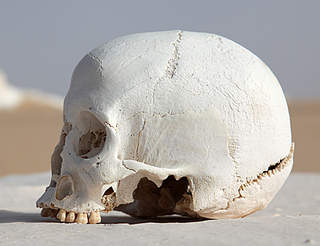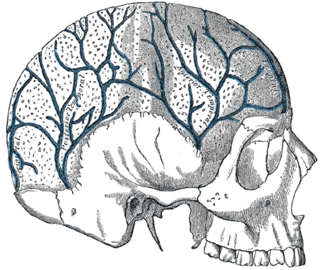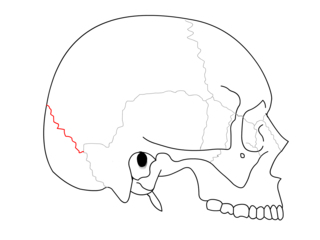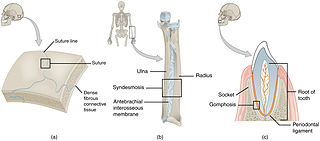This article has multiple issues. Please help improve it or discuss these issues on the talk page . (Learn how and when to remove these template messages) (Learn how and when to remove this template message)
|
The fetal head, from an obstetrical viewpoint, and in particular its size, is important because an essential feature of labor is the adaptation between the fetal head and the maternal bony pelvis. Only a comparatively small part of the head at term is represented by the face. The rest of the head is composed of the firm skull, which is made up of two frontal, two parietal, and two temporal bones, along with the upper portion of the occipital bone and the wings of the sphenoid.

The pelvis is either the lower part of the trunk of the human body between the abdomen and the thighs or the skeleton embedded in it.

The temporal bones are situated at the sides and base of the skull, and lateral to the temporal lobes of the cerebral cortex.

The sphenoid bone is an unpaired bone of the neurocranium. It is situated in the middle of the skull towards the front, in front of the basilar part of the occipital bone. The sphenoid bone is one of the seven bones that articulate to form the orbit. Its shape somewhat resembles that of a butterfly or bat with its wings extended.
These bones are separated by membranous spaces, or sutures. The most important sutures are the frontal, between the two frontal bones; the sagittal, between the two parietal bones; the two coronal, between the frontal and parietal bones; and the two lambdoid, between the posterior margins of the parietal bones and upper margin of the occipital bone. Where several sutures meet, an irregular space forms, which is enclosed by a membrane and designated as a fontanel. The greater, or anterior fontanel, is a lozenge-shaped space that is situated at the junction of the sagittal and the coronal sutures. The lesser, or posterior fontanel, is represented by a small triangular area at the intersection of the sagittal and lambdoid sutures. The localization of these fontanels gives important information concerning the presentation and position of the fetus. The temporal, or casserian fontanels, have no diagnostic

The parietal bones are two bones in the skull which, when joined together at a fibrous joint, form the sides and roof of the cranium. In humans, each bone is roughly quadrilateral in form, and has two surfaces, four borders, and four angles. It is named from the Latin paries (-ietis), wall.

The occipital bone is a cranial dermal bone and the main bone of the occiput. It is trapezoidal in shape and curved on itself like a shallow dish. The occipital bone overlies the occipital lobes of the cerebrum. At the base of skull in the occipital bone, there is a large oval opening called the foramen magnum, which allows the passage of the spinal cord.
It is customary to measure certain critical diameters and circumferences of the newborn head. The diameters most frequently used, and the average lengths thereof, are:
- The occipitofrontal (11.5 cm), which follows a line extending from a point just above the root of the nose to the most prominent portion of the occipital bone.
- The biparietal (9.5 cm), the greatest transverse diameter of the head, which extends from one parietal boss to the other.
- The bitemporal (8.0 cm), the greatest distance between the two temporal sutures.
- The occipitomental (12.5 cm), from the chin to the most prominent portion of the occiput.
- The suboccipitobregmatic (9.5 cm), which follows a line drawn from the middle of the large fontanel to the undersurface of the occipital bone just where it joins the neck.
The greatest circumference of the head, which corresponds to the plane of the occipitofrontal diameter, averages 34.5 cm, a size too large to fit through the pelvis without flexion. The smallest circumference, corresponding to the plane of the suboccipitobregmatic diameter, is 32 cm. The bones of the cranium are normally connected only by a thin layer of fibrous tissue that allows considerable shifting or sliding of each bone to accommodate the size and shape of the maternal pelvis. This intrapartum process is termed molding. The head position and degree of skull ossification result in a spectrum of cranial plasticity from minimal to great and in some cases, undoubtedly contribute to fetopelvic disproportion, a leading indication for cesarean delivery.














